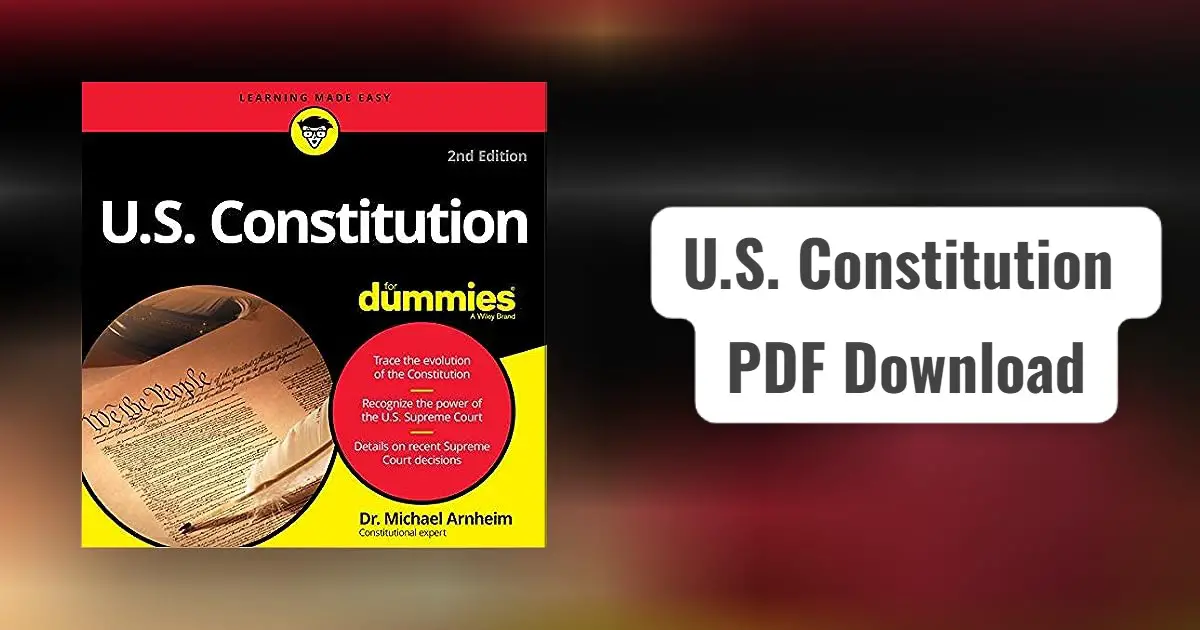U.S. Constitution PDF Free Download
U.S. Constitution : The United States Constitution stands as the cornerstone of the American democratic system, shaping the nation’s governance and safeguarding the rights and liberties of its citizens. This remarkable document, born out of the fervor of revolutionary ideals, has endured the test of time, serving as a guiding light for generations of Americans. In this exploration, we delve into the history, significance, and enduring impact of the U.S. Constitution.

Introduction
The U.S. Constitution, adopted in 1787, remains one of the most revered and studied legal documents in history. Its profound influence extends beyond the borders of the United States, shaping democratic principles worldwide. This article takes a comprehensive look at the U.S. Constitution, exploring its inception, key components, historical context, and the lasting impact it has had on the nation and the world.
The Birth of a Nation: Crafting the Constitution
The Constitution emerged from a desire to forge a stronger union among the original thirteen American colonies. During the Constitutional Convention of 1787, delegates deliberated over the structure of the government and the balance of power between states and a central authority. The resulting Constitution provided a framework that would guide the nation toward a new era of self-governance.
Preamble: The Essence of Purpose
The Preamble eloquently outlines the Constitution’s objectives, emphasizing the establishment of justice, promotion of the general welfare, and the securing of individual freedoms. It reflects the framers’ intent to create a government that serves the people and embodies their ideals.
Separation of Powers: Balance and Checks
Central to the Constitution is the principle of separation of powers. The legislative, executive, and judicial branches were designed to operate independently, preventing any single branch from amassing unchecked power. This system of checks and balances ensures the preservation of democratic governance.
Bill of Rights: Safeguarding Liberties
The first ten amendments, collectively known as the Bill of Rights, enshrine fundamental rights such as freedom of speech, religion, and the press. These amendments serve as a shield against potential governmental overreach and have become a symbol of American democracy.
Amendments: An Evolving Framework
The framers recognized the need for adaptability and included a mechanism for amendments to address evolving societal needs. Over time, the Constitution has been amended to reflect changing values and expanding notions of equality and justice.
Judicial Review: Marbury v. Madison
The landmark case of Marbury v. Madison established the principle of judicial review, empowering the courts to review and potentially invalidate laws that violate the Constitution. This pivotal ruling solidified the judiciary’s role as a guardian of constitutional rights.
Also Read This : Sejarah Dunia Yang Disembunyikan
Federalism: Balancing National and State Powers
The Constitution strikes a delicate balance between federal authority and state autonomy. This federalist structure ensures that both the national government and state governments have defined powers, preventing a concentration of authority.
Constitutional Interpretation: Originalism vs. Living Document
Debates over constitutional interpretation persist. Originalists advocate for adhering strictly to the framers’ original intent, while proponents of the “living document” view believe the Constitution’s principles should be applied to contemporary contexts.
Impact on Democracy and Global Governance
The U.S. Constitution’s influence extends globally, inspiring democratic movements and shaping constitutional frameworks in other nations. Its emphasis on the rule of law, individual rights, and representative governance has left an indelible mark on the course of history.
Challenges and Controversies
Throughout its existence, the Constitution has faced challenges and controversies, including debates over slavery, civil rights, and the scope of executive power. These challenges highlight the document’s capacity to adapt to societal shifts.
Legacy and Enduring Relevance
The U.S. Constitution’s legacy is profound. It remains a guiding force in American governance, reminding citizens of their rights and responsibilities. Its principles continue to inspire individuals and governments striving for a just and equitable society.
Conclusion
The U.S. Constitution stands as a testament to the vision of its framers, encapsulating the principles that underpin American democracy. Through its ingenious design and enduring impact, it remains a beacon of hope, a source of guidance, and a living testament to the power of collective ideals.
FAQs
Que : Can the U.S. Constitution be amended?
Ans : Yes, the Constitution can be amended through a specific process outlined in Article V, allowing for changes to accommodate evolving societal needs.
Que : What is the significance of the Bill of Rights?
Ans : The Bill of Rights guarantees fundamental freedoms and safeguards against government infringement on individual liberties.
Que : How has the Constitution influenced other countries?
Ans : The Constitution’s principles have inspired democratic movements and influenced the creation of constitutional frameworks in various nations.
Que : What is the role of the judiciary in upholding the Constitution?
Ans : The judiciary ensures that laws align with the Constitution and has the authority to strike down laws that violate it.
Que : Has the Constitution been challenged in modern times?
Ans : Yes, debates over issues like executive power, civil rights, and constitutional interpretation continue to shape contemporary discourse.
U.S. Constitution PDF Free Download
Click Here To Download For Free PDF








